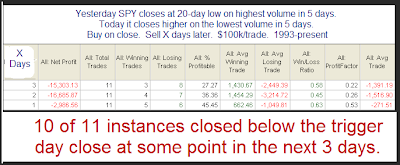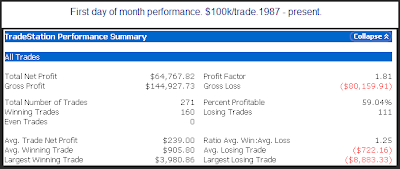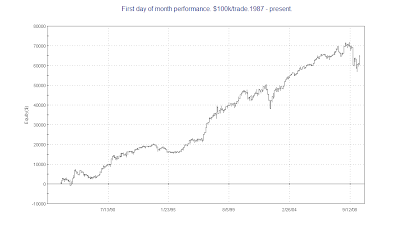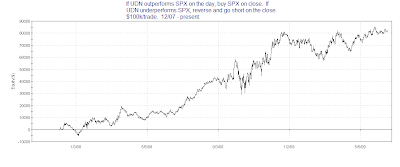We spent Father’s Day at my in-laws. My father-in-law actively trades and a lot of what he does is pairs trading. He’s been getting more involved with pairs lately and comes up with some crazy ones. He does some testing on the computer but a lot of his testing is done “old school” with a pen and paper.
So I brought my laptop over armed with Jeff Pietsch’s ETF Rewind tool. As part of ETF Rewind, Jeff has one worksheet that is set up to do pairs analysis. I rarely see him mention it on his blog, but it is really a cool tool. You can put in any ETFs or stocks (or combination) and see how playing mean reversions following extreme divergences would have played out over the last 6 months. It comes with an optimization feature that allows you see how extreme the optimal settings are and what the best lookback period would be. Running an optimization takes about 15 seconds.
My father-in-law does swing trading so we focused on finding pairs that performed well with short lookback periods and less extreme divergences. He had a whole list he wanted to try out and we were able to zip through them and see which ones had potential and which ones didn’t.
The tool doesn’t do detailed system testing but it’s a great idea checker. So if you’ve thought about playing growth vs. value, or gold vs. gold miners, or even something crazy like AMZN vs. silver, it takes about 30 seconds to find out whether your ideas are worth exploring further, or whether you’re better off scrapping them.
Personally, what I like best about the tool is that it also seems to act as an idea machine. There’s really no end to the possibilities and the more you play with it the more ideas you end up wanting to explore. It also gives you a sense of what to look for when considering certain securities for pairs. Some securities seemed to work well with almost anything paired up with them while others struggled with all combinations. It makes you think deeper about the nature and tendencies of certain sectors and security types.
Anyway, enough from me. Check it out for yourself if you want. I know Jeff offers a 3-day free trial with all his subscription plans (yes – that includes Blogger Triple Play). Just make sure you spend some time playing with the pairs worksheet if you trial it.



















